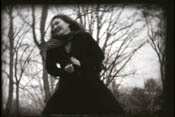When the war started, we thought it was simply impossible.
What, am I supposed to expect my first neighbor to come and kill me?
Oh, come on it's not possible! But it is very possible and it happened.
Tahija Vikalo (1998)
|
In 1991, war broke out in the former Yugoslavia. The ensuing conflicts
left up to a quarter of a million people dead or missing in the
region and made refugees of more than half of the national population
of Bosnia & Herzegovina. And despite wide international attention,
understanding of these conflicts is still vague and detached. |
 |
 |
Tahija Vikalo was just beginning college when the war erupted in Bosnia & Herzegovina. She lived through the worst of the war in Sarajevo, running past snipers on her way home from work. In the summer of 1998, the Picture Me an Enemy crew traveled with Tahija back to her home in Sarajevo. Tracing Tahija's footsteps through the past and into the present, we gain a unique view of Bosnian life and culture as well as the horror she went through. Tahija's introduction to Bosnia challenges stereotypes about her country and the Muslim religion. And her firsthand experience of war is a window into the brutality and suffering that results from such conflicts. |
Natasa Borcanin, originally from Osijek, Croatia, was a high school student when war erupted in Croatia. In formal interviews and intimate settings, Natasa discusses her experience of war breaking out in her country and then what it was like to watch these conflicts unfold on television from the US where she was an exchange student. As a Croat with mixed ethnicity (her father is Serbian and her mother is Croatian), Natasa represents the innate complexity of these wars. She and her family suffered as victims of discrimination in her Croatian hometown and yet for Natasa, the war was "not a war of our generation...we never knew of these hatreds between ethnic groups." Natasa provides a unique perspective on the complexities of personal identity and the danger of assigning people to rigid ethnic groups. |
 |
With candid and revealing perspectives rarely seen on the evening news, Tahija and Natasa provide new insights into these, often-misunderstood, conflicts. And although the documentary focuses on the conflicts of the former Yugoslavia, the themes raised within, reach far beyond the borders of any one country.
 |
Shot in Philadelphia and the former Yugoslavia, Picture Me an Enemy inter-cuts archival news footage and abstract Super 8 vignettes with the post-war reflections of Tahija and Natasa in a style that is both engaging and sincere. This is supplemented with archival footage from the war and a wealth of images of the people and places of the former Yugoslavia. Award-winning editor Barbara Burst combines these elements in an engaging and sincere way. Blending sounds from East, West, folk and pop, the film's soundtrack features the music of diaSonic, an international act recently featured on MTV and Fox Television. The musicians, Milan Kovacev and Damir Prcic, who, like Tahija and Natasa, come from opposing sides of the conflict in the former Yugoslavia, find a common ground through music by combining classical, hip hop and electronic dance music with folk songs from Serbia and Bosnia. |
| This documentary is especially unique because of the visibly sincere friendship developed over six years between the vis à vis productions crew and Tahija & Natasa. As they share their experiences, the viewer is introduced to the images, humor, culture and life of the former Yugoslavia in an up close and intimate way. |  |
|
|
The target audience for Picture Me an Enemy is people who care little about issues of war and conflict, and would rarely ever sit down to watch a "war documentary." Although told through the voices of two women from the former Yugoslavia, the themes raised throughout Picture Me an Enemy reach far beyond the borders of any one country. At its core, this is a story of two women who have the same fears, hopes and dreams as women anywhere. |
||
"Reflections on the Making of Picture Me an Enemy"
|
Current
Status of Project |
Project
Advisors |
Production
Credits |
Production
Personnel |
News/Press
Coverage |
Film
Endorsements |
|
Length:
30 minutes
Format: shot on mini DV and super 8 film, plus archival footage
If you are interested in obtaining a copy of Picture
Me an Enemy,
please contact Women Make Movies.
We
are still seeking (and in need of) support for the documentary. If you
can help, please email us at visavisproductions@yahoo.com.
| HOME | SYNOPSIS | BALKAN LINKS | BALKAN IMAGES |
| READING | COMMENTS | VIS A VIS |
All photographs and images on this site are the property of vis à vis productions
and may not be used or reproduced in any way without written permission.